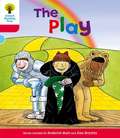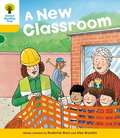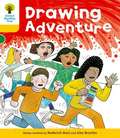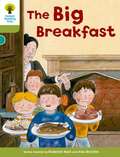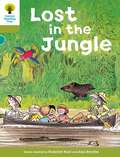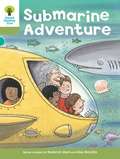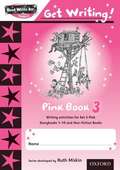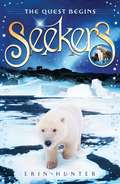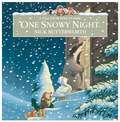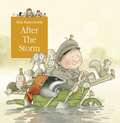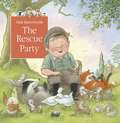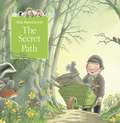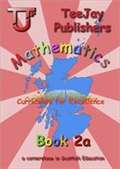- Table View
- List View
Oxford Reading Tree, Stage 4, Storybooks: The Play (2011 edition)
by Roderick HuntThe children put on a play of The Wizard of Oz.
Oxford Reading Tree, Stage 5, More Stories B: New Classroom (2011 edition)
by Roderick HuntThe children are excited about the new classroom being built. The get a tour of the building site and look at their new classroom when it is ready, where Wilf finds a suprise behind the door!
Oxford Reading Tree, Stage 5, More Stories C: Drawing Adventure (2011 edition) (PDF)
by Roderick HuntThe Magic Key pulls Biff, Chip and Wilma into their drawings of volcanoes and girls wearing clothes designed by Wilma.
Oxford Reading Tree, Stage 5, More Stories C: Drawing Adventure (2011 edition)
by Roderick HuntThe Magic Key pulls Biff, Chip and Wilma into their drawings of volcanoes and girls wearing clothes designed by Wilma.
Oxford Reading Tree, Stage 7, More Stories B: The Big Breakfast (2011 edition) (PDF)
by Roderick HuntMum was away and Dad had been unable to prepare breakfast for Biff, Chip and Kipper. Therefore they all went to the cafe and had a nice big breakfast. When they got home, Dad told them that they must all work to tidy the house up before Mum got back.
Oxford Reading Tree, Stage 7, More Stories B: The Big Breakfast (2011 edition) (PDF)
by Roderick HuntMum was away and Dad had been unable to prepare breakfast for Biff, Chip and Kipper. Therefore they all went to the cafe and had a nice big breakfast. When they got home, Dad told them that they must all work to tidy the house up before Mum got back.
Oxford Reading Tree, Stage 7, Stories: Lost in the Jungle (2011 edition)
by Roderick Hunt"Biff asked Anneena's mum to help her buy a plant. They went into a big green house. The greenhouse was hot, and it was full of plants. 'What a lot of plants!' said Biff. 'It's like a jungle in here. I don't know which one to buy.' In the end, she found one that she liked. 'I'll get this one for Mum,' she said." This book is part of the phenomenally successful Oxford Reading Tree which is used to teach reading in 80% of primary schools. The stories within it are about much-loved Biff, Chip and Kipper, their friends and family, and the exciting adventures they have together. They are carefully graded across 9 stages and contain built-in progression and vocabulary repetition throughout. Each book includes notes for parents/carers and teaching assistants on the inside covers.
Oxford Reading Tree, Stage 7, Stories: Lost in the Jungle (2011 edition) (PDF)
by Roderick Hunt"Biff asked Anneena's mum to help her buy a plant. They went into a big green house. The greenhouse was hot, and it was full of plants. 'What a lot of plants!' said Biff. 'It's like a jungle in here. I don't know which one to buy.' In the end, she found one that she liked. 'I'll get this one for Mum,' she said." This book is part of the phenomenally successful Oxford Reading Tree which is used to teach reading in 80% of primary schools. The stories within it are about much-loved Biff, Chip and Kipper, their friends and family, and the exciting adventures they have together. They are carefully graded across 9 stages and contain built-in progression and vocabulary repetition throughout. Each book includes notes for parents/carers and teaching assistants on the inside covers.
Oxford Reading Tree, Stage 7 Storybooks: Submarine Adventure (2011 edition)
by Roderick HuntBiff, Chip, Wilf and Wilma have an exciting undersea adventure in a submarine.
Oxford Reading Tree, Stage 7 Storybooks: Submarine Adventure (2011 edition) (PDF)
by Roderick HuntBiff, Chip, Wilf and Wilma have an exciting undersea adventure in a submarine.
Read Write Inc. Phonics: Wuff Wuff (PDF)
by Ruth Miskin Gill MuntonThe Ditties are short, phonically decodable passages based on the letter sounds learned in Speed Sounds Set 1. Each book contains three Ditties and seven reading activities, including: a list of Speed Sounds to practise before reading each Ditty, a list of Green words and Red words ('tricky' high-frequency words) and questions to talk about. The Ditties prepare children to quickly move on to the Storybooks, building their vocabulary and ensuring they will be able to decode all the words in the stories with confidence. There are accompanying Get Writing! Red Ditty Books which provide practice in early writing skills and a Get Writing! Handbook which contains guidance on how to use the Ditties to support children's writing. Full guidance on using the Ditties as part of Read Write Inc. can be found in the Read Write Inc. Phonics Handbook.nbsp;
Read Write Inc. Phonics, Pink 3, Writing Activities: Get Writing! (PDF)
by Ruth MiskinThe Get Writing! books contain activities linked to the core Storybooks in Read Write Inc., and to selected Non-fiction books for each level. The writing activities build on the reading activities that children have completed, helping them to develop ideas and vocabulary for writing. Specific activities included are: Hold a sentence - remembering/writing a sentence linked to the Storybook/Non-fiction booknbsp; Edit - correcting errors in a sentence Write - writing about a picture from the Storybook or Non-fiction book, e.g. filling in a speech bubble or thought bubble from one of the characters, completing a 'wanted' poster or writing a simple recipe. At higher levels:nbsp; 'Fred Rhythms' for spelling (sounds and graphemes) . Spelling check (partner work) Take a spelling test . Build a sentence - supporting children as they write a sentence Write - more sophisticated writing frames to inspire and support children as they write.
Seekers, Book 1: The Quest Begins
by Erin HunterThree bears; one incredible journey to the ends of the Earth. The remarkable follow-up series to the New York Times best-seller, Warriors. Three bears from very different worlds are about to embark on the quest of a lifetime. Kallik is a polar bear from the frozen expanse of the Arctic Circle, Lusa is a black bear restricted to the confinement of the zoo and Toklo is a grizzly bear faced with the unpredictability of the Rocky Mountains.
Tales from Percy's Park: One Snowy Night (PDF)
by Nick ButterworthPercy the Park Keeper helps his animal friends in this popular story from highly-regarded, best-selling author-illustrator Nick Butterworth. Percy the Park Keeper always feeds the animals in the park where he lives. But one cold winter's night Percy discovers that his little friends need more than food and he must find a way to help them find a warm place to sleep for the night. Percy's hut is nice and warm but Percy discovers that if you invite one animal in you'll have to invite them all in and his hut is only small - it's certainly going to be a squash!
Tales from Percy's Park: After the Storm (PDF)
by Nick ButterworthPercy the Park Keeper helps his animal friends in this engaging story from highly-regarded, best-selling author-illustrator Nick Butterworth. A storm is raging outside and Percy the Park Keeper is having a sleepless night. When he gets up the following morning, Percy finds that the old oak tree has been blown down. It is a disaster for his animal friends who live there, but Percy is soon devising a plan to help his little friends find new homes in the best tree house they have ever seen!
Tales From Percy's Park: The Rescue Party (PDF)
by Nick ButterworthPercy the Park Keeper goes on a rescue mission wtih his animal friends in this engaging story from highly-regarded, best-selling author-illustrator Nick Butterworth. Percy the park keeper is having a day off. It is a perfect day for doing nothing. But Percy's peaceful picnic is disturbed when a little rabbit meets with a nasty tumble into an old well. All the animals gather together with a huge rope to help pull the rabbit out. But all they tug from the well is the branch of a tree. But the rabbit has already found her own way out.through an passage under the ground and she's at the end of the line with the other animals lending a hand!
Tales From Percy's Park: The Secret Path (PDF)
by Nick ButterworthPercy the Park Keeper is in for a surprise in this funny story from highly-regarded, bestselling author-illustrator Nick Butterworth. It's a beautiful spring morning and a perfect opportunity for Percy to trim the overgrown maze. The animals decide to have some fun hiding on the stone lion in the middle of the maze, to surprise Percy. But the suprise is on them when they fall asleep and Percy, finding them, hides behind the statue and pretends his voice is the lion's telling them to wake up. Percy has unravelled some string through the maze to help him find the way out but the squirrel, thinking he is helping, has wound the string into a ball.nbsp;
Teejay Mathematics Cfe Level 2 Book A (PDF)
by Tom Strang James Geddes James CairnsTrust TeeJay's proven approach, which successfully develops mathematical skills and adds fun to learning. This book provides hundreds of practice questions, with progression and consolidation - the core TeeJay philosophy - underpinning every exercise and chapter. - Use Book 2A followed by Book 2B to cover the entire Level 2 curriculum - Chapter Zero revises all of the strands from Level 1 - Every chapter ends with 'The 3Rs' exercise so that pupils can Revisit, Review and Revise that topic - Extension work provides extra stretch for high-attaining pupils - Answers for all questions are in the back of the book; answers for 'The 3Rs' are available on the TeeJay Maths website
Alphabet- G to L (Large Print)
by RnibIn this series, there are two A5 images per A4 sheet. Cut each sheet along the fine vertical line down the centre to make two pages with an image on each. There will be a locator shown at the top left of each image when it is the correct way up. At the bottom right of each image, you will find its initial letter in lower and upper case braille and print characters.G is for grape - This image shows four grapes on a stem. The cut end of the grape's stem is at the top of the image. It branches out to the oval shapes of the sweet purple grapes further down the page.H is for hand - This is an image of a child's hand. The hand is seen from the back with its fingers in the top left of the page and thumb to the right. The wrist is in the bottom right of the page. Each finger and the thumb have a nail shown.I is for ice cream - This is a picture of a cool and delicious ice cream cone. At the top right of the picture is the pink strawberry ice cream. The cone with its patterned surface is further down the page. It tapers down to a point in the bottom left. J is for jug - This is an image of a pottery jug. The jug fills most of the page; its spout, where you pour out liquids, can be found at the top left of the image and the handle is on the right. The jug is pale yellow and has horizontal blue stripes.K is for key - This is an image of a key for a mortice lock. The grey metal key is in the middle of the page; its handle is at the top of the image. At the bottom of the image is the part of the key that you put in the lock to open it.L is for leaf - This is an image of a single green leaf from a tree. This is a leaf from a maple tree. It is in the middle of the page with its stalk to the right. On the main part of the leaf, its veins can be found branching out from the centre to the leaf.
Alphabet- G to L (UEB Contracted)
by RnibIn this series, there are two A5 images per A4 sheet. Cut each sheet along the fine vertical line down the centre to make two pages with an image on each. There will be a locator shown at the top left of each image when it is the correct way up. At the bottom right of each image, you will find its initial letter in lower and upper case braille and print characters.G is for grape - This image shows four grapes on a stem. The cut end of the grape's stem is at the top of the image. It branches out to the oval shapes of the sweet purple grapes further down the page.H is for hand - This is an image of a child's hand. The hand is seen from the back with its fingers in the top left of the page and thumb to the right. The wrist is in the bottom right of the page. Each finger and the thumb have a nail shown.I is for ice cream - This is a picture of a cool and delicious ice cream cone. At the top right of the picture is the pink strawberry ice cream. The cone with its patterned surface is further down the page. It tapers down to a point in the bottom left. J is for jug - This is an image of a pottery jug. The jug fills most of the page; its spout, where you pour out liquids, can be found at the top left of the image and the handle is on the right. The jug is pale yellow and has horizontal blue stripes.K is for key - This is an image of a key for a mortice lock. The grey metal key is in the middle of the page; its handle is at the top of the image. At the bottom of the image is the part of the key that you put in the lock to open it.L is for leaf - This is an image of a single green leaf from a tree. This is a leaf from a maple tree. It is in the middle of the page with its stalk to the right. On the main part of the leaf, its veins can be found branching out from the centre to the leaf.
Alphabet- G to L (UEB Uncontracted)
by RnibIn this series, there are two A5 images per A4 sheet. Cut each sheet along the fine vertical line down the centre to make two pages with an image on each. There will be a locator shown at the top left of each image when it is the correct way up. At the bottom right of each image, you will find its initial letter in lower and upper case braille and print characters.G is for grape - This image shows four grapes on a stem. The cut end of the grape's stem is at the top of the image. It branches out to the oval shapes of the sweet purple grapes further down the page.H is for hand - This is an image of a child's hand. The hand is seen from the back with its fingers in the top left of the page and thumb to the right. The wrist is in the bottom right of the page. Each finger and the thumb have a nail shown.I is for ice cream - This is a picture of a cool and delicious ice cream cone. At the top right of the picture is the pink strawberry ice cream. The cone with its patterned surface is further down the page. It tapers down to a point in the bottom left. J is for jug - This is an image of a pottery jug. The jug fills most of the page; its spout, where you pour out liquids, can be found at the top left of the image and the handle is on the right. The jug is pale yellow and has horizontal blue stripes.K is for key - This is an image of a key for a mortice lock. The grey metal key is in the middle of the page; its handle is at the top of the image. At the bottom of the image is the part of the key that you put in the lock to open it.L is for leaf - This is an image of a single green leaf from a tree. This is a leaf from a maple tree. It is in the middle of the page with its stalk to the right. On the main part of the leaf, its veins can be found branching out from the centre to the leaf.
Alphabet- M to R (Large Print)
by RnibIn this series, there are two A5 images per A4 sheet. Cut each sheet along the fine vertical line down the centre of the sheet, to give two pages with an image on each. There is a locator dot shown, which will be at the top left of the page when the image is the correct way up. At the bottom right of each image, you will find its initial letter in lower and upper case braille and print characters.M is for magnet - This image shows a magnet, a nail and a nut. The magnet is in the shape of a horseshoe; it is in the top left of the page and has two ends that curve down towards the centre of the page. The curved part of the magnet is painted red and the two ends are grey metal. The magnet attracts things that are made of iron. There is a nail stuck to the top end of the magnet and a six-sided metal nut stuck to the nail further down the page.N is for newt - This is a picture of a newt seen from the top. The dull green newt is a little amphibian creature; it lives in water and on land. Its head is on the centre left of the page with its body to the right. The newt's four legs can be found up and down from its body. Each of its feet has four toes. At the right of the image is the newt's long tapered tail.O is for owl - This is a picture of an owl seen from the side and facing right. The owl is in the centre of the page. Its head is in the top right of the page and it is turned to face you so that both its eyes and beak can be found. Down and to the left is the owl's body and folded wing. Its two legs are down from its wing and its tail feathers are to the bottom left.P is for pie - This is an image of an apple pie with a golden crust. It is seen form above. The round pie is in the centre of the page. A triangular slice has been cut out of the pie ready to eat, on the right of the page.Q is for queen - This is an image of a queen's head. The queen's head is in the middle of the page. She is facing you so that all the parts of her face can be found. At the top of the image is the queens golden crown, it is encrusted with red, green and blue jewels. Down from the crown the queenâ TMs face can be found. She has brown eyes with long lashes and long black hair, which covers her ears, to each side of her face.R is for ring - This is a picture of a ruby ring. The ring is seen from the side in the centre of the page. It has been shown about five times bigger than its actual size. The red ruby is at the top of the image. You can feel the way it has been cut to make it sparkle in the light. The circular ring curves down to the bottom part of the page.
Alphabet- M to R (UEB Contracted)
by RnibIn this series, there are two A5 images per A4 sheet. Cut each sheet along the fine vertical line down the centre of the sheet, to give two pages with an image on each. There is a locator dot shown, which will be at the top left of the page when the image is the correct way up. At the bottom right of each image, you will find its initial letter in lower and upper case braille and print characters.M is for magnet - This image shows a magnet, a nail and a nut. The magnet is in the shape of a horseshoe; it is in the top left of the page and has two ends that curve down towards the centre of the page. The curved part of the magnet is painted red and the two ends are grey metal. The magnet attracts things that are made of iron. There is a nail stuck to the top end of the magnet and a six-sided metal nut stuck to the nail further down the page.N is for newt - This is a picture of a newt seen from the top. The dull green newt is a little amphibian creature; it lives in water and on land. Its head is on the centre left of the page with its body to the right. The newt's four legs can be found up and down from its body. Each of its feet has four toes. At the right of the image is the newt's long tapered tail.O is for owl - This is a picture of an owl seen from the side and facing right. The owl is in the centre of the page. Its head is in the top right of the page and it is turned to face you so that both its eyes and beak can be found. Down and to the left is the owl's body and folded wing. Its two legs are down from its wing and its tail feathers are to the bottom left.P is for pie - This is an image of an apple pie with a golden crust. It is seen form above. The round pie is in the centre of the page. A triangular slice has been cut out of the pie ready to eat, on the right of the page.Q is for queen - This is an image of a queen's head. The queen's head is in the middle of the page. She is facing you so that all the parts of her face can be found. At the top of the image is the queens golden crown, it is encrusted with red, green and blue jewels. Down from the crown the queenâ TMs face can be found. She has brown eyes with long lashes and long black hair, which covers her ears, to each side of her face.R is for ring - This is a picture of a ruby ring. The ring is seen from the side in the centre of the page. It has been shown about five times bigger than its actual size. The red ruby is at the top of the image. You can feel the way it has been cut to make it sparkle in the light. The circular ring curves down to the bottom part of the page.
Alphabet- M to R (UEB Uncontracted)
by RnibIn this series, there are two A5 images per A4 sheet. Cut each sheet along the fine vertical line down the centre of the sheet, to give two pages with an image on each. There is a locator dot shown, which will be at the top left of the page when the image is the correct way up. At the bottom right of each image, you will find its initial letter in lower and upper case braille and print characters.M is for magnet - This image shows a magnet, a nail and a nut. The magnet is in the shape of a horseshoe; it is in the top left of the page and has two ends that curve down towards the centre of the page. The curved part of the magnet is painted red and the two ends are grey metal. The magnet attracts things that are made of iron. There is a nail stuck to the top end of the magnet and a six-sided metal nut stuck to the nail further down the page.N is for newt - This is a picture of a newt seen from the top. The dull green newt is a little amphibian creature; it lives in water and on land. Its head is on the centre left of the page with its body to the right. The newt's four legs can be found up and down from its body. Each of its feet has four toes. At the right of the image is the newt's long tapered tail.O is for owl - This is a picture of an owl seen from the side and facing right. The owl is in the centre of the page. Its head is in the top right of the page and it is turned to face you so that both its eyes and beak can be found. Down and to the left is the owl's body and folded wing. Its two legs are down from its wing and its tail feathers are to the bottom left.P is for pie - This is an image of an apple pie with a golden crust. It is seen form above. The round pie is in the centre of the page. A triangular slice has been cut out of the pie ready to eat, on the right of the page.Q is for queen - This is an image of a queen's head. The queen's head is in the middle of the page. She is facing you so that all the parts of her face can be found. At the top of the image is the queens golden crown, it is encrusted with red, green and blue jewels. Down from the crown the queenâ TMs face can be found. She has brown eyes with long lashes and long black hair, which covers her ears, to each side of her face.R is for ring - This is a picture of a ruby ring. The ring is seen from the side in the centre of the page. It has been shown about five times bigger than its actual size. The red ruby is at the top of the image. You can feel the way it has been cut to make it sparkle in the light. The circular ring curves down to the bottom part of the page.
Alphabet S to Z (Large Print)
by RnibIn this series, there are two A5 images per A4 sheet. Cut each sheet along the fine vertical line down the centre of the sheet, to give two pages with an image on each. There is a locator dot shown, which will be at the top left of the page when the image is the correct way up. At the bottom right of each image, you will find its initial letter in lower and upper case braille and print characters.S is for spoon - This is an image of a spoon. The spoon's grey stainless steel bowl is in the top right of the page. Down and to the left is the black plastic handle of the spoon. It has two round rivets to hold It onto the spoon's body.T is for triangle - This is a picture of a triangle, not the shape, but the musical instrument you might play in your school orchestra. At the top of the image is a green ribbon that you hold the triangle by; it is looped around the top corner of the triangle. The triangle is made from steel rod that has been bent into a three-sided shape. The triangle slopes down the page to the left and right. At the bottom of the triangle is the third side. At the bottom right of the page is the small rod that you use for striking the triangle to make a ringing sound.U is for umbrella - This is a picture of an umbrella seen from the side. The green canopy, (the fabric covering) of the umbrella is at the top right of the page, with the spiky end pointing towards the top. The umbrella's ribs curve down from the end with the fabric of the canopy arched between them at the bottom. The long tube of the umbrella goes down and left to the curved brown wooden handle at the bottom left of the page.V is for vase - This image shows a vase seen from the side with two flowers in it. At the top of the page there are two mauve coloured flowers facing you. Their green stems go down the page to the neck of the vase. The vase has a curved shape; it is coloured grey with a band of yellow, blue and pink decoration across its widest part.W is for watch - This is a picture of a watch seen from the front. Part of the watches brown leather strap is in the top right corner of the page. It has holes in it for size adjustment. Down and left is the watch face. It is seen from the front so all of the hands can be found. There is a long thick minute hand, a short thick hour hand and a long thin second hand. The small winding knob is on the right hand side of the watch face. Around the outside of the watche's face are small marks to show the hours. Further down and left is the rest of the strap and at the bottom left of the page is the small buckle for fastening the strap.X is for xylophone - This is an image of a toy xylophone: a type of musical instrument. The xylophone is in the middle of the page. It has bars of metal that you hit with the hammer at the bottom of the page to make a bell-like sound. There are eight differently coloured bars on this toy. Each one is fixed with two pins. The largest one is on the left of the page and makes the lowest note. The smallest is on the right and makes the highest note.Y is for yacht - This is an image of a toy yacht (sailing boat). The yacht is seen from the side and is facing to the left. At the top of the image is a tiny triangular red flag attached to the mast going down the page. To each side of the mast are the two triangular sails that catch the wind to move the boat. Further down the page is the boatâ TMs hull with a decorative stripe going across it and down again are the keel in the centre to steady the yacht, and the rudder on the right to steer it.Z is for zebra - This is a picture of a stripy zebra. The zebra is part of the horse family. This zebra is seen from the side and faces to the left. It is covered in mostly vertical black and white stripes. Its head is on the top left of the page and both of its ears can be found. To the right is the zebraâ TMs neck going down and right to its body. You can find its tail on the far right of the image and its four stripy legs down from its body.
